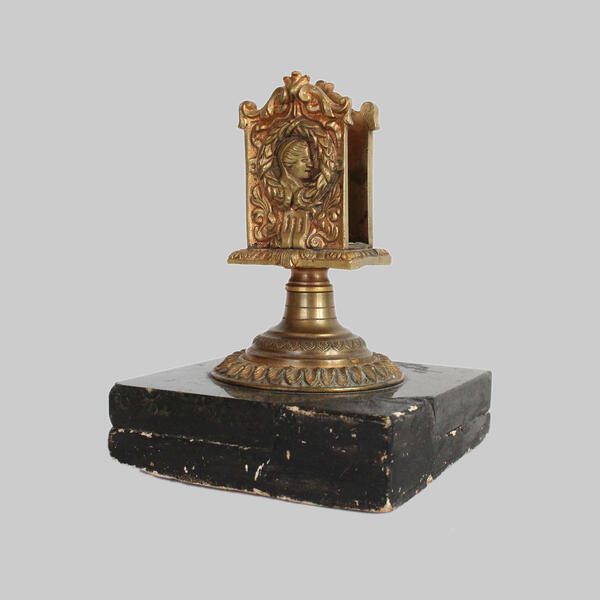Match holders are a typical 19th century household item. They came about after the invention of so-called safe matches in 1844. The matches used up to that point could easily ignite, even from minimal friction with one another. The new chemical composition with the addition of red phosphorus made using them safe for anyone.
The match holder served as a sort of case for the matchbox. Match holders were generally based on the dimensions of the match boxes they were to hold. The makers took into account the item’s application and released several types, including tabletop, fireplace, and pocket versions. Tabletop match holders were mounted onto a standing leg, decorated with precious stones and engraved drawings, which were filled with niello or colored enamel. Brass and copper were predominantly used in manufacturing fireplace match holders. Such match holders were intended for large matchboxes and were usually true works of art. Pocket match holders were completely metal with two holes.
Various materials were used in manufacturing match holders, including bronze, silver, aluminum and brass. Each of these materials gave the work a unique personality and quality.
The match holder depicted here is a tabletop version, composed of three parts: the box holder, the leg, and the base. This holder is made of yellow metal with two parallel rectangular plates with a figured rise in the middle. On the front side you can see a relief image of a woman with a wreath on her head in profile. The leg was made short, with a circular cross-section decorated with small relief ornaments, and two belts with floral ornaments cut out on a round stepped base. The base is made of two square plates. The upper plate is made of black stone with green veins, while the lower plate is made of plaster, covered with black paint.
This match holder was added to the Yalutorovsk museum complex in 1994. It was acquired by museum staff during a business trip to St. Petersburg specifically for the exposition in the memorial house, which opened after it’s restoration.
The match holder served as a sort of case for the matchbox. Match holders were generally based on the dimensions of the match boxes they were to hold. The makers took into account the item’s application and released several types, including tabletop, fireplace, and pocket versions. Tabletop match holders were mounted onto a standing leg, decorated with precious stones and engraved drawings, which were filled with niello or colored enamel. Brass and copper were predominantly used in manufacturing fireplace match holders. Such match holders were intended for large matchboxes and were usually true works of art. Pocket match holders were completely metal with two holes.
Various materials were used in manufacturing match holders, including bronze, silver, aluminum and brass. Each of these materials gave the work a unique personality and quality.
The match holder depicted here is a tabletop version, composed of three parts: the box holder, the leg, and the base. This holder is made of yellow metal with two parallel rectangular plates with a figured rise in the middle. On the front side you can see a relief image of a woman with a wreath on her head in profile. The leg was made short, with a circular cross-section decorated with small relief ornaments, and two belts with floral ornaments cut out on a round stepped base. The base is made of two square plates. The upper plate is made of black stone with green veins, while the lower plate is made of plaster, covered with black paint.
This match holder was added to the Yalutorovsk museum complex in 1994. It was acquired by museum staff during a business trip to St. Petersburg specifically for the exposition in the memorial house, which opened after it’s restoration.



